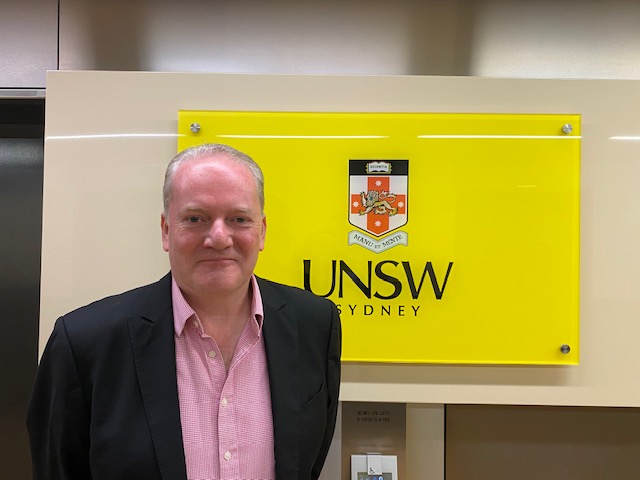The now of work | AGSM - UNSW Sydney
Why the future of work has already arrived and what leaders can do to prepare
Why the future of work has already arrived and what leaders can do to prepare

Why the future of work has already arrived and what leaders can do to prepare
What was once touted as the ‘future of work’ is here today, as the impact of technological disruption, globalisation and demographic shifts take hold across Australia’s agile workspaces and collaborative hubs.
The World Economic Forum has declared a ‘reskilling emergency’. Its latest report into the impact of the Fourth Industrial Revolution on jobs suggests 42% of core skills required to perform existing jobs will change by 2022. That’s just two years away – and Paul Mills, School Faculty Member and Learning Experience at AGSM @ UNSW Business School, believes it has never been more important to invest in reskilling and upskilling.
“We need to stop talking about the future of work, because the future is here now,” he says. “If people and culture leaders address this now, their organisations will be able to adapt to ongoing change – and maintain their competitive advantage.”
The Now of Work recognises the impact of the Fourth Industrial Revolution – particularly automation, AI and machine learning – on a diverse range of occupations today. While some jobs are already being displaced, many more new skills have been identified as potential shortfalls. The impact is being felt across different industries.
A new mindset for the Now of Work
In an era of hyper-change, leaders require a different combination of skills and mindsets to be effective. “Learning agility plays a role in achieving greater organisational adaptability,” explains Mills. “The ability to learn at pace from different experiences, and to embrace tough situations because they are often the best opportunities to learn.”
Mills says challenging assignments play a vital role in effective education. He describes this as “learning through experimentation, learning from setbacks and stepping out of your comfort zone.”
As automation and artificial intelligence (AI) continue to displace the workforce, human intelligence (HI) has become paramount. Employees are increasingly expected to creatively exploit digital technologies, which makes skills such as complex problem solving, emotional intelligence, social influence and resilience essential.
“It is important to contemplate what the interplay will look like between AI and HI, knowing that human skills will become even more important in the future,” Mills says.
“The future workforce will need to know how to learn new things, but also let go of old skills and knowledge bases. They need to be able to adapt, by reflecting on themselves and also on the system in which they operate as leaders. To solve increasingly complex problems, they need to know how to collaborate, to encourage others to bring a different lens to a situation.”
Re-thinking talent development
Traditionally, learning and development programs have focused on an elite few: identifying and nurturing top talent within the organisation. But Mills believes this approach will also need to fundamentally change.
“High-performing individuals can find transition difficult,” he explains. “They’re the experts, which makes it hard for them to get out of their comfort zone. Successful transition can mean letting go of old strengths, which in some cases have been built up over years and even decades.”
Instead, he advocates opening programs up across the organisation. “Progressive organisations are adopting a meritocracy approach, recognising anyone who demonstrates learning agility could be a potential future leader.”
One example is Woodside Energy, a leading Australian natural gas producer. Recognising training as an investment in people, rather than a cost, it has worked with AGSM to deliver Perth-based leadership programs. Diverse topics include Leading Others, The Power of Influence and Resiliency.
Woodside’s new campus headquarters in Perth, WA, is a purpose-built physical manifestation of the Now of Work. It’s designed to facilitate better collaboration and better shared problem solving. However, providing the physical space for agile working is only the first step. To help its employees adjust to this new way of working, AGSM also developed leadership programs to support the psychological transition, breaking old habits and building trust in dispersed teams.
The adaptive learning advantage
For more than 40 years, AGSM has designed and delivered evidence-based executive education programs with practical relevance for leaders today. These also match the challenges they and their organisations will face in the future.
Like its clients and partners, AGSM is also undergoing its own transition into the Now of Work. “We have a digitally-savvy faculty who are quickly becoming experts in high-impact online delivery – well beyond a traditional workshop mode,” Mills says. “Our delivery modes already reflect where the world is at right now.”
Having spent more than 25 years working in the corporate and government sectors, Mills also understands the risks of falling behind.
“One of the greatest advantages of the Now of Work is diversity and inclusion,” he says. “This is what gives us the capacity to solve complex problems – and to better meet changing customer needs.”
Another benefit is the ability to attract future top talent. As certain skills become more limited in the future, those people will have more choices and the war for talent will intensify. “We’re now seeing a generation that heavily weights employee experience into their decisions – part culture, part physical work environment,” he explains.
Ultimately, Mills sees the Now of Work as an opportunity to build resilience for everything the future holds. “You will have the right talent, the right culture and the right environment to turn those disruptive changes into opportunities for your organisation.”
Find out more about AGSM’s Short Courses for long term success.